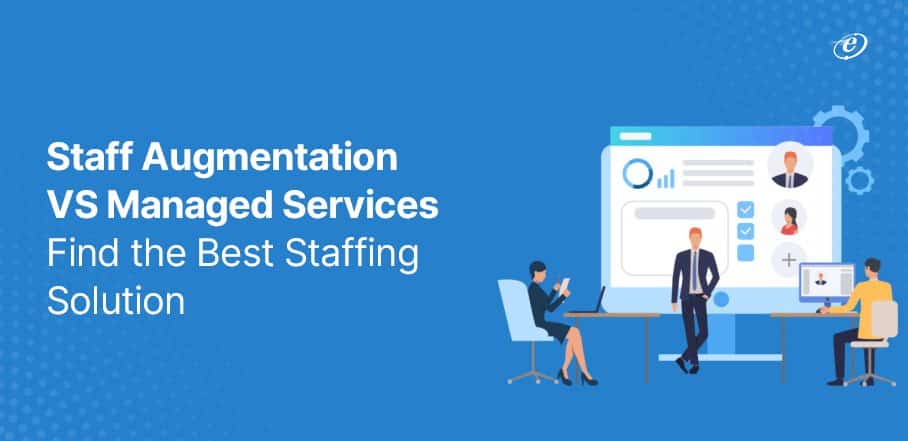
Staff Augmentation vs Managed Services: Find the Best Staffing Solution
Businesses no longer have to be restricted to a specific region due to the development of technology and remote work; instead, they may now access a global talent pool. This article will compare the two most effective IT models for corporate growth—staff augmentation vs managed services. Although these models are interchangeable, they are different from one another. Understanding these distinctions will help you choose wisely and develop the ideal business plan.
The worldwide IT professional services market reached USD 821.58 billion in 2022, and it is projected to increase at a CAGR of 9.1% from 2023 to 2030. (Source: Grand View Research)

Another report shows that in 2020, the global market for IT outsourcing was estimated to be worth USD 318.5 billion. By 2026, it is anticipated to have grown to USD 425.19 billion, showing a CAGR of 4.5%. (Source: globalnewswire.com)
The data mentioned above shows that businesses today are not solely dependent on internal staff but rather hire knowledgeable professionals to find novel solutions.
Staff augmentation and managed services are two prominent business models because they provide several advantages, such as cost savings, access to specialist knowledge, greater efficiency, and flexibility in growing operations.
Out of IT Managed services vs staff augmentation, managed services are better suited for firms that need long-term support and want to outsource complete projects. In contrast, staff augmentation is a wonderful option for those who need flexibility and have short-term, specialized needs.
Read a comparative guide on Staff Augmentation vs Outsourcing.
Comparative Analysis of Staff Augmentation and Managed Services
A quick comparison of staff augmentation vs managed services is summarized in the table below.
| Aspect | Staff Augmentation | Managed Services |
| Use case | Short-term project | Long-term project |
| Engagement | Full-time | Full-time/Part-time |
| Cost-Effectiveness | Cost-effective for short-term needs | Cost-effective over the long run |
| Flexibility | High | Depends on the contract |
| Processes | Responsibility for giving an input | Responsibility for delivering an outcome |
| Billing | Based on time spent on the project, often twice weak | Billed on retainer, often annually |
| Risk | Client | Service provider |
Let’s discuss the major differences between managed services and staff augmentation. So that, selecting the best type for your ongoing work will be simpler.
Let’s get started!
What is Staff Augmentation?
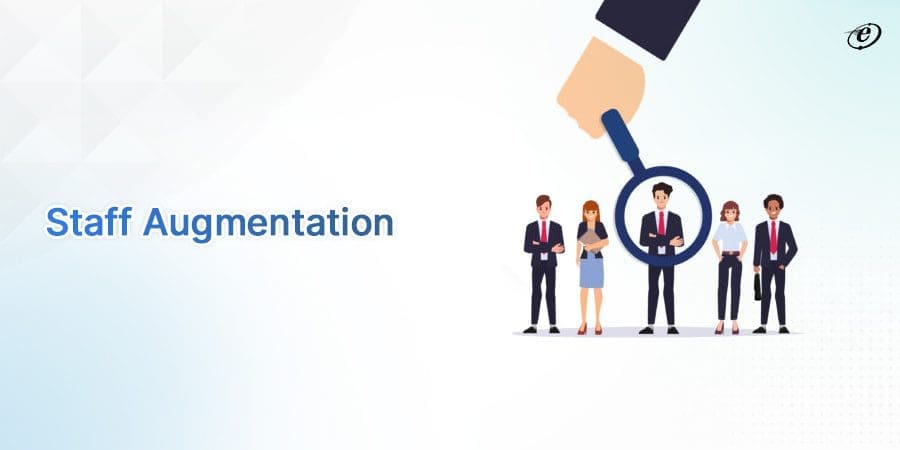
One of the most common models for software development outsourcing is staff augmentation. It entails the service provider hiring additional technical talent or IT expertise.
This approach enables organizations to quickly scale their capabilities, expertise, and resources to meet specific project needs or fill skill gaps. It is commonly used in the tech industry for software development, but it can be applied to various fields, enabling companies to adapt to changing demands and deliver projects more efficiently.
IT staff augmentation can be more effective than full-time professionals, lowering software development costs. Companies can accomplish project goals using this technique without incurring excessive staffing costs for IT personnel.
Understand staff augmentation with an example:
A company facing a tight project deadline and lacking certain programming skills opts for staff augmentation. They temporarily hire external developers with expertise in a specific programming language to join their in-house team. This allows the company to complete the project on time, leveraging specialized skills without needing permanent hires.
Types of Staff Augmentation Models
| Staff Augmentation Model | Explanation |
| Short-Term | This model involves hiring additional personnel for a brief period, often to address immediate project requirements. Short-term augmentations are ideal for handling spikes in workload, seasonal demands, or specific short-term projects. |
| Long-Term | It involves hiring personnel for an extended duration. Organizations opt for this approach when they anticipate ongoing or extended project needs but prefer to retain flexibility rather than commit to full-time hires. |
| Hybrid | Organizations often combine various staff augmentation models to optimize their workforce. For instance, they might have an onshore team for project management and an offshore team for development. |
| Skill-Based | Skill-based staff augmentation focuses on hiring individuals with specific skills or expertise required for a particular project or task. This model is especially useful when organizations lack in-house expertise. |
| Highly Skilled | This model entails hiring individuals with advanced or niche skills, often at the top of their field. Organizations choose highly skilled staff augmentation when they need exceptional expertise or experience that may be scarce in the job market. |
What are Managed Services?

Managed service is the practice of outsourcing specific IT functions or tasks to a third-party provider, often on a subscription or contract basis. Virtually everything can be outsourced by businesses to managed service providers. Along with software development, this also involves cybersecurity, data migration, and database administration.
Managed service providers work independently rather than becoming a part of the company’s internal IT team. After receiving permission, they present a quote and project timetable to the client, whom they work with to complete their assigned task.
Managed services are especially valuable for organizations seeking cost-effective and reliable solutions to meet IT requirements while reducing their in-house workload.
Understand managed services with an example:
Small businesses partner with an MSP for IT-managed services. The MSP monitors the company’s network remotely, provides regular software updates, and offers 24/7 support for helpdesk. This proactive approach prevents system failures, resolves technical issues swiftly, and ensures the business can operate smoothly without the burden of managing its IT infrastructure in-house.
Types of IT Managed Services Models
| Staff Augmentation Model | Explanation |
| Co-Managed IT Services | Co-managed IT services involve collaboration between an organization’s in-house IT team and an external service provider. |
| Managed Network Services (MNS) Model | MNS providers focus on managing and optimizing an organization’s network infrastructure, ensuring performance, security, and reliability. |
| Managed Security Services (MSS) Model | MSS providers specialize in cybersecurity. They offer continuous monitoring, threat detection, and incident response services to protect an organization’s digital assets. |
| Project-Based Model | Under this model, organizations hire IT service providers to complete specific IT projects, such as system upgrades, migrations, or software development. |
| Hybrid Model | Many organizations combine multiple service models to create customized approaches that cater to their unique needs. For example, they may use MSP services for routine maintenance while engaging CSPs for cloud resources. |
Staff Augmentation vs Managed Services: Discover the Competitive Benefits
Why Choose the Staff Augmentation Model?

Staff Augmentation is a valuable strategy for organizations looking to optimize their workforce, enhance project outcomes, and maintain a competitive edge in a rapidly changing business environment. Here are some of the top benefits of employing this strategy.
-
Flexibility
Staff augmentation companies provide a high degree of flexibility in workforce management. You can quickly scale up or down your team in response to changing project demands, market conditions, or business objectives. This adaptability is especially valuable in dynamic industries where requirements may fluctuate frequently.
-
Shorter Time-to-Market
Rapid resource acquisition and specialized skills expedite project timelines. This means your company can bring services and products to the market faster, gaining a competitive advantage and capturing market share more quickly.
-
Project Specific Focus
You can build a collaborative team with staff augmentation tailored to the specific needs of a project. This means you can deploy the right skills and expertise for each task, enhancing the likelihood of successful project completion and minimizing downtime.
-
Scale Rapidly
Businesses scale rapidly with staff augmentation by quickly adding external experts to their teams. This on-demand access to specialized skills and resources enables them to take on larger projects, meet tight deadlines, and expand their capabilities without the delays and costs of traditional hiring.
-
Operational Efficiency
Leading staff augmentation companies support operational efficiency by offering flexible working environments. Companies collaborating with supplying organizations avoid paying the infrastructure costs of building and running in a new location. Therefore, in addition to lowering the cost of hiring skilled individuals, staff augmentation services also cut operating costs.
-
Sustained Control & Management
One of the biggest advantages of staff augmentation is that only the human resources are outsourced to an external agency, as opposed to project outsourcing, where the full operations of a project are transferred to an external unit. The management is still in place. With this management power, businesses can keep a firm grip on their initiatives and mold them in anyway..
Read a detailed comparison guide on staff augmentation vs outsourcing.
Why choose the IT Managed Services Model?
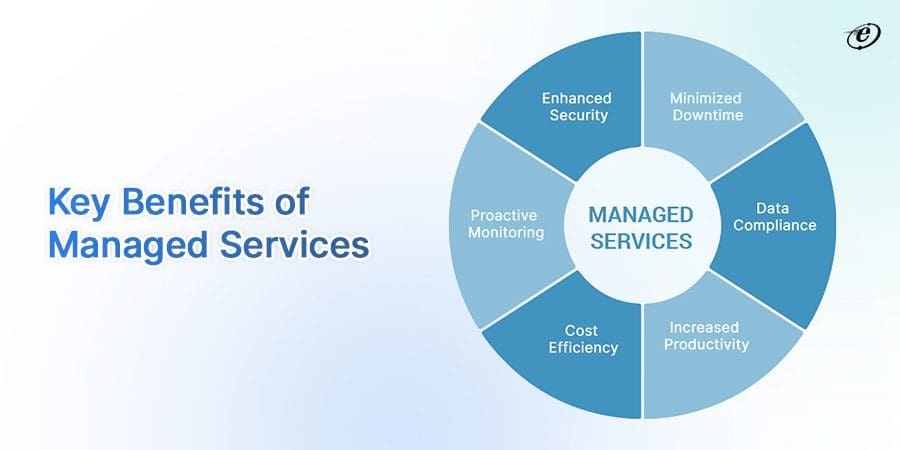
-
Enhanced Security
Nowadays, cybersecurity is a growing concern for businesses of all sizes. Managed service providers have the latest security tools and expertise to protect their clients’ data and systems from threats. This proactive approach can help enterprises avoid costly data breaches and reputational damage.
-
Minimized Downtime
Unintentional human mistakes cause the majority of downtime, and there is little you can do to prevent it. An internal team might not have the resources or expertise to reduce the risk of downtime. Managed services minimize downtime through continuous monitoring, rapid issue detection, and timely resolution. Expert managed services providers employ 24/7 monitoring tools to identify potential problems before they disrupt operations.
-
Data Compliance
A plethora of laws (e.g., HIPAA) intended to protect data security apply to your company’s data. You won’t need to be concerned about breaking data security laws because a managed services provider will handle the challenging aspects of compliance and auditing. They can also perform audits and create reports demonstrating that your company complies with all regulations.
-
Increased Productivity
Your staff can work more productively when your IT systems are functioning properly. By keeping systems up-to-date and ensuring that they are properly configured, MSPs can contribute to increased productivity. MSPs can offer them training and support to help end users get the most out of your technology.
-
Cost Efficiency
One of the primary reasons of choosing of managed services is cost efficiency. Instead of investing heavily in in-house IT infrastructure and personnel, organizations can outsource their IT needs to MSPs, who can provide services at a fraction of the cost. This shift from a capital expenditure (CapEx) model to an operational expenditure (OpEx) model allows businesses to manage their budgets better and allocate resources more effectively.
-
Proactive Monitoring
Proactive monitoring in managed services involves continuous, real-time surveillance of IT systems. Advanced tools and automated processes are used to detect anomalies, performance issues, and potential threats. This allows managed service providers to identify and address problems before they impact operations, ensuring system reliability.
Key Differences Between Staff Augmentation and Managed Services
Let’s compare staff augmentation vs managed services in terms of cost, flexibility, scalability, security, and level of control.

-
Staff Augmentation vs Managed Services: Which is more flexible?
Out of IT managed services vs staff augmentation, staff augmentation can be more flexible, as the organization can recruit external IT experts on a long-term basis or bring them in on a project-by-project basis to give additional support as needed,
Conversely, managed services frequently entail a longer-term contract with the provider, and the company may have less freedom to change the nature of the job being done.
Ultimately, the flexibility choice between staff augmentation and managed services depends on whether you need temporary, direct workforce control (staff augmentation) or ongoing, specialized support (managed services).
-
Staff Augmentation vs Managed Services: Which is more scalable?
Managed services tend to be more scalable than staff augmentation. Managed services providers (MSPs) can quickly adjust resources and expertise to match an organization’s evolving needs. They offer scalability through service-level agreements (SLAs) and can provide a huge range of services, from basic support to complex solutions, as the business grows.
Staff augmentation, while flexible, may require more effort to scale as it involves hiring additional personnel directly. It can also be constrained by the availability of specific skills in the job market.
Hence, we can say that managed services offer a smoother path to scalability, making them a preferred choice for organizations with dynamic and growing IT requirements.
-
Staff Augmentation vs Managed Services: Which is cost effective?
When comparing staff augmentation and managed services, staff augmentation can be less expensive for urgent needs because businesses simply pay for the hours the outsourced employee’s work.
Explore the future of IT staff augmentation.
This technique is particularly advantageous when only a few personnel are required for a particular project or skill gap. Hiring staff augmentation is typically less expensive than using a managed service provider (MSP) for the same purpose.
Managed Services, on the other hand, provide more predictable prices because businesses pay a set monthly fee for the management and upkeep of their IT systems. For successful results, this expenditure is required.
Although the fixed fee for the services may be more expensive than hiring additional workers for short-term initiatives, managed services can reduce costs by streamlining processes, boosting security, and offering long-term support and maintenance.
-
Staff Augmentation vs Managed Services: Level of control and oversight
Staff augmentation gives organizations better oversight and control over their projects. To ensure that the project meets its expectations and criteria, clients can choose particular tasks and set a time limit for completion. With this level of control, businesses can keep a close eye on the status of their projects and make necessary adjustments to ensure that goals and deadlines are met.
In contrast, managed services involve outsourcing specific functions or responsibilities to a third-party provider, limiting direct control over the details of operations. While managed services offer expertise and efficiency, organizations typically need more immediate control and oversight, especially in areas managed by the service provider.
The choice between the two models depends on the organization’s preference for control and the nature of the tasks at hand.
-
Staff Augmentation vs Managed Services: Which is more customizable?
Staff augmentation is more customizable than managed services. In staff augmentation, organizations have greater flexibility to tailor the hired personnel’s skills, expertise, and roles to meet specific project or task requirements. This customization precisely fits the organization’s unique needs, ensuring that the external talent aligns closely with existing teams and workflows.
Managed services, while offering valuable expertise and standardized solutions, may have less room for customization because they typically follow predefined service packages and processes. Organizations looking for highly specialized or uniquely configured solutions often prefer staff augmentation for its ability to adapt to their precise needs.
-
Staff Augmentation vs Managed Services: Which provides more security
Managed services generally provide more comprehensive security compared to staff augmentation. Managed services providers (MSPs) specialize in security protocols, monitoring, and threat detection, offering a dedicated focus on safeguarding IT infrastructure and data. They often employ a team of experts to address security vulnerabilities and respond rapidly to emerging threats proactively.
In contrast, staff augmentation companies primarily focus on augmenting a client’s workforce with additional personnel. While these augmentees may have security expertise, the level of security provided depends on the organization’s internal security practices and policies. With their specialized security focus, managed services offer higher protection and vigilance against cybersecurity threats and vulnerabilities.
Explore the top skills to look for in an IT Staff Augmentation Partner.
Staff Augmentation vs Managed Services: Pros & Cons
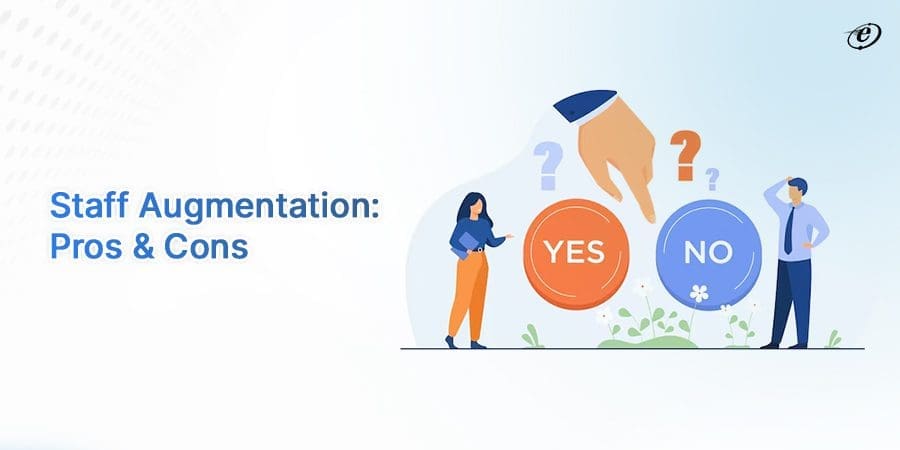
Here is a concise table outlining the pros and cons of staff augmentation.
| Pros | Cons |
| Organizations retain full control over augmented staff. | Administrative complexities in managing external personnel. |
| Quick resource scaling is needed. | Integration challenges within the existing team. |
| Reduced long-term labor costs, only pay for what’s used | Recruitment and onboarding time may slow response to changing needs. |
| Learning opportunities from external experts | Knowledge and expertise leave with augmented staff. |
| Access to niche skills and expertise. | Augmented staff are often temporary, leading to workforce turnover. |

Here is a concise table outlining the pros and cons of managed services.
| Pros | Cons |
| Access to specialized skills and knowledge. | Reduced direct control over processes and operations. |
| Streamlined operations and optimized processes. | May not always be the most cost-effective option, especially for smaller organizations. |
| Enables internal teams to focus on strategic initiatives. | Over-reliance on the service provider may pose challenges. |
| Fixed pricing structures for budgeting. | Managed services may not always align with limited budgets, particularly for smaller organizations. |
| Continuous monitoring and issue resolution. | Quality may vary depending on the service provider’s performance. |
Staff Augmentation vs Managed Services: Best Use Cases
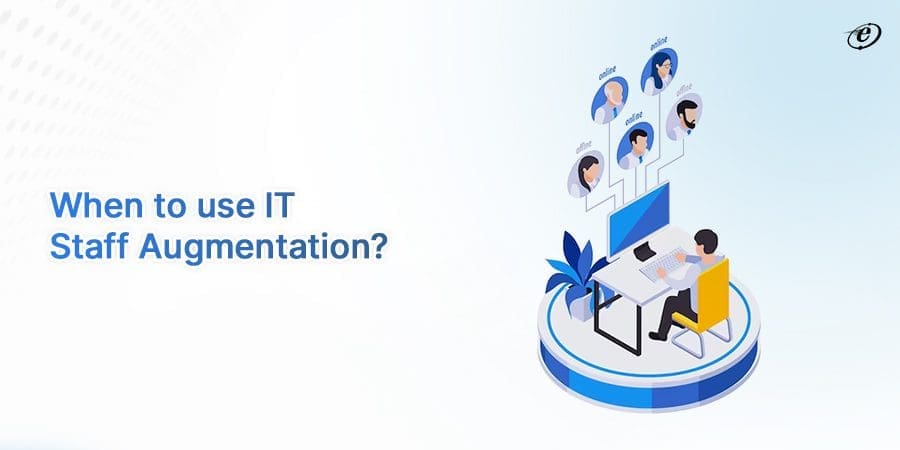
- Ideal for temporary, project-based work requiring specific skills.
- If you want to scale the workforce to meet fluctuating project demands rapidly.
- Bringing in experts to mentor and train internal teams.
- Filling in-house skill deficiencies with specialized external expertise.
- Reducing labor costs by avoiding long-term hires for short-term needs.
- Augmenting existing teams with specialized skills for specific tasks.

- For round-the-clock IT assistance, issue resolution, and user support.
- Comprehensive protection against evolving threats, with 24/7 monitoring and threat detection.
- Meeting industry-specific regulations and standards for data security and privacy.
- Efficiently managing and optimizing cloud resources and services.
- Ensuring the performance, security, and availability of databases.
- Managing and maintaining network infrastructure for reliability and performance.
Choosing the Right Model for Your Business
Although choosing to outsource your IT services can be a terrific choice, there are a few considerations you should weigh up before deciding your outsourcing models.
Similarly, managed services and staff augmentation are not a one-size-fits-all option. It depends on the scope of your project, your financial constraints, the degree of control you want, and your long-term IT plan.
The key to choosing one out of staff augmentation vs managed services is to thoroughly assess your unique requirements, analyze the benefits and drawbacks, and choose based on what will best suit the aims and objectives of your firm.
If you are still confused about which would be the best fit for your project, the experts at eLuminous Technologies can assist you in selecting the ideal staffing solution for your company. To find out more, call us right away!
Frequently Asked Question
-
What is the difference between staff augmentation and outsourcing?
Staff augmentation involves hiring temporary personnel to work alongside your team, maintaining control over the project. Outsourcing entails contracting external providers to handle tasks transferring responsibility but gaining specialized expertise.
Read more about staff augmentation vs. outsourcing.
-
Which is more cost effective, staff augmentation vs managed services?
Staff augmentation is often more cost-effective for short-term, project-specific needs, as you have more control over resources. Managed services can be cost-effective for ongoing, complex tasks, as providers offer specialized expertise and manage resources efficiently.
Find the offshore software development cost by country.
-
How can I ensure data is secure when using any outsourcing model?
Conduct thorough due diligence on potential service providers to ensure data security in any outsourcing model. Assess their security practices, certifications, and compliance with data protection regulations.
We at eLuminous Technologies establish robust security requirements in contracts, including encryption, access controls, and regular security audits. Besides that, we monitor data handling processes closely, and have contingency plans for security breaches.
-
Which is less time consuming, IT managed services vs staff augmentation?
IT managed services are typically less time-consuming as they involve outsourcing the management of specific IT functions or systems to a specialized provider. On the other hand, staff augmentation requires more time and effort to recruit, onboard, and manage additional personnel, which can be incredibly time-consuming for short-term projects.
-
What are staff augmentation services?
Staff augmentation services provide you with external professionals to fill skill gaps and meet project needs on a temporary or project-specific basis. This flexible hiring model allows you to scale your workforce quickly in your organization, access specialized expertise, and reduce costs associated with full-time hires.





